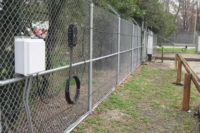In an age where security threats have become an all-too-common reality, safeguarding the expansive perimeters of commercial enterprises presents an intricate web of challenges that demand innovative solutions.
From the various physical aspects of a site to a multitude of infrastructure limitations; plus the complexities of today’s operations and the pitfalls of security solutions available — it’s more difficult now than ever to secure a large property from risk.
There are a number of perimeter security challenges that large commercial property managers and security teams are facing today.
Understanding the challenges of securing large physical properties
1. Scale and complexity
Managing and monitoring a vast and complex perimeter can be overwhelming. Coordinating security measures across large areas requires comprehensive planning and robust resources.
2. Resource allocation
Assigning adequate personnel and technology resources to cover an extensive perimeter can be resource intensive. Effective surveillance, patrols and response mechanisms must be established to deter and/or address potential security breaches promptly.
3. Limited surveillance coverage
Achieving consistent surveillance coverage across every inch of an expansive perimeter can be difficult. Blind spots may emerge due to terrain, equipment, lighting, structures or other obstacles, offering potential entry points for intruders.
4. Real-time monitoring and response
Maintaining real-time monitoring capabilities across a large site can be technologically challenging. Delays in identifying and responding to security threats could exacerbate the impact of a breach or future threats.
5. Cost
Implementing and maintaining a comprehensive perimeter security system, including personnel, equipment and technology upgrades can often be costly.
6. Balancing security and access
Striking the right balance between a secure perimeter and the need for convenient access for authorized personnel, visitors and deliveries requires careful management and can be especially challenging at larger sites where the volume is heavy.
Overcoming these challenges demands a holistic approach that integrates technology, personnel and processes to ensure a robust and effective perimeter security strategy.
The importance of securing large commercial property perimeters
The vastness of these properties and their operations are exactly what makes them a high-risk target for criminal activity. The fact is large sites, while challenging to secure, are the most important to secure.
Large sites are typically located in more rural areas. The assumption may be, the further away from the high crime city environment, the lower the risk to the property. This assumption would be flawed, as it doesn’t account for the sophistication of today’s criminals. Consider this: with fewer people around, the chances of being seen are low; law enforcement is less abundant, delaying response time; and people generally have a “nothing happens around here” mentality, and therefore let their guard down.
Methodical criminals know large sites have weak points. They’ll learn who has a secure perimeter by cutting the fence, breaching and then waiting for response, sometimes for days or weeks. If the breach goes unnoticed, as is likely to happen on an unsecured large site, the criminal knows they have an easy target.
Finally, the reality is, businesses are forced to balance security budgets with other business initiatives. Criminals know, too often, businesses are more likely to take the reactive approach rather than a proactive approach. Weigh the cost savings associated with effective security investments rather than the initial investment, nine times out of 10, it will make sense to invest in securing a large site.
Start a conversation about the potential vulnerabilities of the large perimeter and what the potential impact of a breach could have on a property, profits, productivity, reputation or most importantly — the organization’s people. Security leaders will quickly see the necessity and find ways to overcome the challenges.







